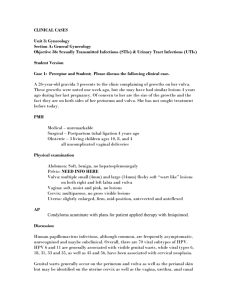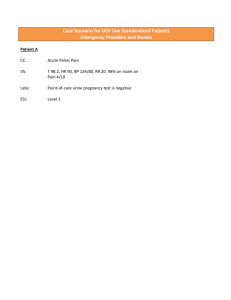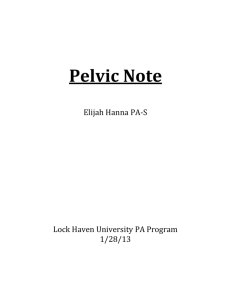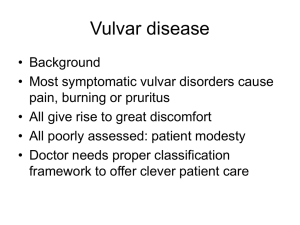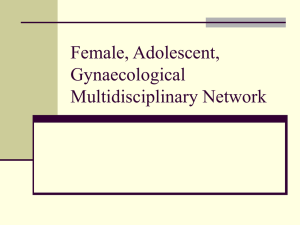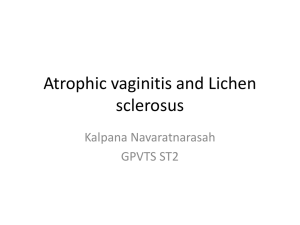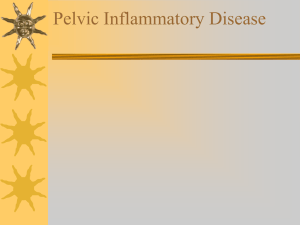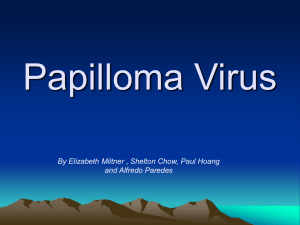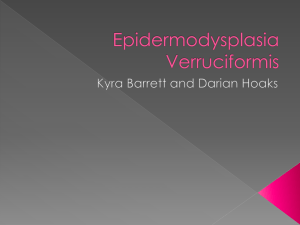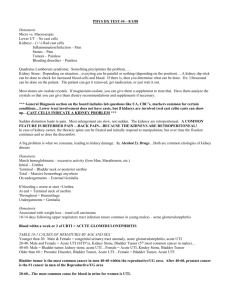Gynecology Clinical Cases: STIs & UTIs
advertisement
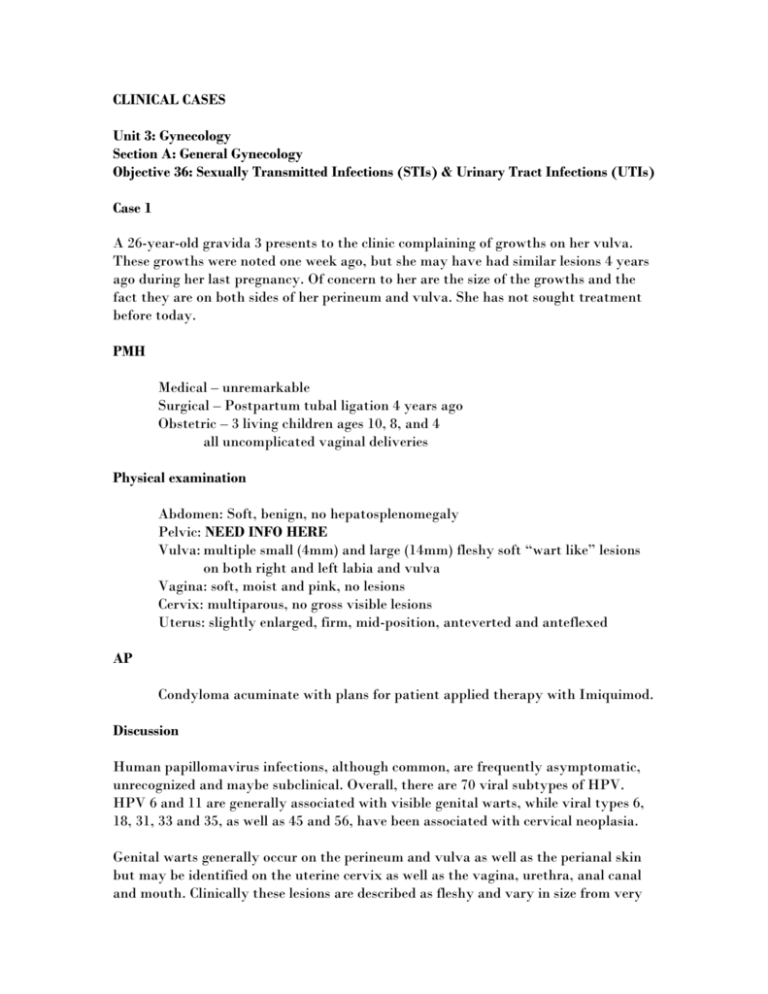
CLINICAL CASES Unit 3: Gynecology Section A: General Gynecology Objective 36: Sexually Transmitted Infections (STIs) & Urinary Tract Infections (UTIs) Case 1 A 26-year-old gravida 3 presents to the clinic complaining of growths on her vulva. These growths were noted one week ago, but she may have had similar lesions 4 years ago during her last pregnancy. Of concern to her are the size of the growths and the fact they are on both sides of her perineum and vulva. She has not sought treatment before today. PMH Medical – unremarkable Surgical – Postpartum tubal ligation 4 years ago Obstetric – 3 living children ages 10, 8, and 4 all uncomplicated vaginal deliveries Physical examination Abdomen: Soft, benign, no hepatosplenomegaly Pelvic: NEED INFO HERE Vulva: multiple small (4mm) and large (14mm) fleshy soft “wart like” lesions on both right and left labia and vulva Vagina: soft, moist and pink, no lesions Cervix: multiparous, no gross visible lesions Uterus: slightly enlarged, firm, mid-position, anteverted and anteflexed AP Condyloma acuminate with plans for patient applied therapy with Imiquimod. Discussion Human papillomavirus infections, although common, are frequently asymptomatic, unrecognized and maybe subclinical. Overall, there are 70 viral subtypes of HPV. HPV 6 and 11 are generally associated with visible genital warts, while viral types 6, 18, 31, 33 and 35, as well as 45 and 56, have been associated with cervical neoplasia. Genital warts generally occur on the perineum and vulva as well as the perianal skin but may be identified on the uterine cervix as well as the vagina, urethra, anal canal and mouth. Clinically these lesions are described as fleshy and vary in size from very small to very large. Classically, the lesions are described as soft fleshy growth and are termed condyloma acuminata or venereal warts. The diagnosis of condyloma acuminata is based not only on physical findings, but may be confirmed by biopsy of the genital warts. Management options include destruction of the lesions using either electrocautery laser or local incision, as well as chemical destruction using podophyllotoxin or trichloroacetic acid. Other methods of therapy include immunological means using interferon, intralesional or Imiquimod patient-applied therapy. The current CDC recommendations are that the first line of therapy includes patient applied therapy using Podofilox 5% solution or gel or Imiquimod 5% cream. There is no evidence that would suggest that any of these regimens are superior to the others and the treatment should be guided based on the preference of the patient. Importantly, if the patient has not improved symptomatically and the lesions begun resolving after 3 weeks therapy, the therapy should be changed to provider administered treatment. In the case of women with cervical warts, high-grade squamous intraepithelial lesions must be excluded before treatment is initiated. Treatment for cervical warts and/or vaginal warts includes cryotherapy or TCA. Follow up of women who have had genital warts includes regular annual examinations and Pap smears. Teaching points HPV is a most common STD with more than 70 DNA subtypes. HPV 6, 11 are associated with genital warts. HPV 16, 18, 31, 33, 35, 45, 56 associated with cervical cancer. Diagnosis based on clinical exam and/or biopsy. Treatment involves physical destruction of lesions using electrocautery, laser, local excision, or chemical destruction (Podophyllotoxin or trichloroacetic acid) or immunological (Interferon or Imiquimod). Case 2 A 16-year-old G1P1 where LMP was one week ago presents with a one-week history of severe lower abdominal pain. Pain is constant, bilateral and accompanied by fever and chills. She has had some nausea and several episodes of vomiting. She has been sexually active for 3 years and has had unprotected intercourse with several partners. She denies irregular bleeding, dysmenorrhea or dyspareunia. PMH Medical – negative except childhood illness Surgical – Tonsillectomy as a child Obstetrical – Gravida1, para1, uncomplicated vaginal delivery one year ago Physical exam Ill appearing 16-year-old T 38.6o P 94 BP 124/82 R 22 Abd: Bilateral lower abdominal tenderness, slightly distended with rebound, negative psoas and Murphy’s signs Pelvic: BUS negative vag – pink, moist, cervix - purulent discharge from os, indurated uterus – midline position, soft, tender adnexa – bilateral fullness and moderately tender Labs GC: positive RPR: negative WBC: 17.6 with left shift UA: few WBC’s, no bacteria, 3 plus ketones UHCG: negative Diagnosis Acute salpingitis with peritoneal findings. Admit for parenteral antibiotics. Discussion The most common presenting complaint of women who have PID is lower abdominal pain. Associated symptoms include vaginal discharge, irregular bleeding, dysmenorrhea, dyspareunia, dysuria, nausea, vomiting and fever. Women who have gonococcal infection have evidence of more acute inflammation (peritoneal signs, fever, leukocytosis) than those who have nongonococcal infection because of the endotoxin produced by N gonorrhoeae. Most women who have acute PID present during the first half of the menstrual cycle. Presentation later in the cycle indicates an infection of longer duration and increases the likelihood that a TOA has organized. Atypical presentations of PID are common and complicate the differential diagnosis. For example, the symptoms of Fitz-Hugh-Curtis syndrome may mimic hepatitis or cholecystitis. All PID treatment regimens must provide broad-spectrum coverage of likely pathogens, including N gonorrhoeae, C trachomatis, anaerobes, gram-negative bacteria and streptococci. Although broad-spectrum antibiotic coverage results in symptomatic improvement in most patients, the risk of long-term sequelae remains high. Adolescents are at particularly high risk for future reproductive complications because of their tendency not to complete prescribed treatment regimens. The CDC, therefore, recommends serious consideration of hospitalization for all adolescents who have PID. Hospitalization is especially recommended if compliance is unpredictable, the diagnosis is uncertain, or pelvic abscess is suspected. Hospitalization is essential if the patient is pregnant, has HIV infection or is too ill to tolerate or has failed to respond to outpatient therapy. All patients who are managed as outpatients must be reevaluated within 72 hours of the initiation of antibiotics. Sex partners of patients with PID should be examined and treated if they had sexual contact with the patient in the 60 days prior to the onset of symptoms. Partners should be treated empirically for N gonorrhoeae and C trachomatis, regardless of the apparent etiology of the PID or pathogens isolated from the infected woman. Without treatment of infected partners, risk of reinfection is high. Teaching points Pelvic pain, fever and vaginal discharge are the most common findings if secondary to gonococcal infection. Patients maybe asymptomatic if chlamydia is the causative organism. Salpingitis is usually secondary to gonorrhea or chlamydia infections or both. Diagnostic gold standard is laparoscopy. Treatment regimens consist of an inpatient or outpatient protocol. Sequelae include chronic pelvic pain, ectopic pregnancy and infertility. References Centers for Disease Control and Prevention. Sexually Transmitted Disease Treatment Guideline 2002. MMWR 2002; S1:48-52; www.cdc.gov/std/treatment/default.htm. McCormack WM. “Pelvic inflammatory disease.” N Engl J Med. 1994;330:115-119. Paavonen J. Dermatol Clin 1998 Oct; 16(4): 747-56, xii. Pletcher JR. Pediatr Rev 1998 Nov; 19(11):363-7. Smith M, Shimp L. Women’s Health Care, 20 Common Problems 2000, 433-6. Case 3 Ms. Sandy R is a 32-year-old, G2P0020 female who comes into the ER having experienced 8 hours of right lower quadrant pain. The pain is sharp, stabbing and intermittent in nature and non-radiating to the back. It is associated with 3-4 episodes of nausea and vomiting that preceded the pain. She also complains of dizziness and has had loose bowel movements since the onset of the pain. The pain increases with movement. Fetal position is least painful. She had a similar episode of pain 10 years ago. A laparoscopy was performed at that time and was negative for pathology. Ms. R states that her last menstrual period ended yesterday. She denies being sexually active currently. She denies fever, chills, dysuria, increased urinary frequency, hematuria, melena, vaginal discharge, or vaginal bleeding or spotting. Ms R has allergies to penicillin and no other known allergies. Ms. R is not taking any medications currently. Menstrual history is menarche at age 13, cycles every 26 days with 5 days of bleeding. She had a chlamydia infection 9 years ago that was treated with antibiotics. Two years ago she had a vaginal monilia infection that was treated with Monistat. Her last Pap smear (1 year ago) was normal. She has used oral contraceptives intermittently for 8-10 years and last used them 2 years ago. Ms. R has never used an intrauterine device. She is presently not using any type of birth control method. She denies having a history of hypertension, diabetes, heart disease, asthma or kidney disease. Surgical history Tonsillectomy 17 years ago, laparoscopy 10 years ago and elective abortions without complications 6 and 8 years ago. Social history Ms. R lives alone in an apartment and works as a sales clerk. She denies smoking, drinks 1-2 beers on the weekend and denies use of recreational drugs. She has no family history of hypertension, heart disease, asthma, kidney disease, diabetes or bleeding disorders. Review of symptoms Unremarkable. Physical examination The physical examination reveals a 32-year-old female in no apparent distress. She is alert and oriented x 3. Vital Signs: Temperature: 99.2° F (oral) Blood pressure: 112/70 mm Hg, supine 116/72 mm Hg, sitting Pulse: 96 beats/minute, supine 100 beats/minute, sitting Respirations: 16 breaths/minute Weight/height: 128lbs; 4’11” HEENT: Unremarkable Neck Exam Reveals no cervical lymphadenopathy or thyromegaly Lung Exam: Clear Heart Exam: Heart tones normal without a murmur. She has good peripheral pulses. Abdomen: Obese with positive bowel sounds and is tender to palpation throughout; uterine tenderness greater in the right lower quadrant. There is positive guarding and rebound tenderness. Pelvic Exam: Reveals normal external genitalia, pink, rugose vaginal walls and a closed os with green discharge. The uterus and adnexa cannot be evaluated completely secondary to pain. Cervical motion tenderness cannot be ruled out. Rectal Exam: Guaiac negative and without masses. Extremities: Without cyanosis, clubbing, or edema. Few superficial varicosities are seen on upper legs. Neurologic Exam: Grossly within normal limits. On admission WBC: 11.1 Hemoglobin: 14.3 Hematocrit: 41.7 Urinalysis: Negative Segs: 77 Bands: 18 Platelets: Normal estimate PT: 115% PTT: 23 seconds Pregnancy Test: Negative Hospital course Ms. R. is prepared for the OR. Surgical report Ms. R. was anesthetized, placed in the dorsal lithotomy position, prepped and draped in the usual manner. An infraumbilical incision was made and a Trocar was inserted without complications. Vaginally, a single-toothed tenaculum was used to grab the anterior lip of the cervix and a Hulka manipulator was placed. A suprapubic incision was made and a second Trocar was inserted under direct visualization. Upon entering the peritoneum, free pus was encountered. The appendix was inflamed, but it appeared to be a periappendicitis without evidence of any acute perforation or intrinsic inflammation of the appendiceal wall. Some of the rest of the serosa of the terminal ileum and cecum also appeared inflamed. Upon exploring Ms. R a little more inferiorly, a pocket of pus is entered and approximately 100cc of fairly liquid pus found; this was cultured. Upon inspection of the right tube and ovary, there appeared to be a luteinized cyst in the right ovary that was in the process of decompressing. The right tube had marked scarring with what appeared to be a hydrosalpinx with fimbriae scarring at the end. On inspection of the left tube, there was marked dilatation of the distal tube with fairly normal diameter, approximately 1cm from the left cornu of the uterus. At this point, there was a marked hydrosalpinx with a pyogenic component, with creamy pus emanating from the area just by the fimbriae, which appeared almost necrotic. The left ovary was not involved. The diagnosis of acute left salpingitis was made. The pelvis was irrigated and the instruments were removed. The incision was closed with 3-0 Vicryl. The patient was extubated and taken to the recovery room in stable condition. Post-operative diagnosis Peritonitis with acute salpingitis of the left tube. Hydrosalpinx of the right tube with fimbria scarring. Peri-appendiceal inflammation. Procedure Diagnostic laparoscopy Post-operative Ms. R. continued to spike fevers. Her cultures from the OR revealed Escherichia coli, Neisseria gonorrhoeae and Bacteroides fragilis. Blood cultures were subsequently drawn during one of the temperature spikes, which revealed E. coli. Eventually, 3 days post-operatively, Ms. R. developed induration and redness at the wound site. The sutures were removed and the wound was packed open for the duration of her hospital stay. Ms. R. was maintained on Gentamicin and Cleocin for 5 days postoperatively. She had Gentamicin levels drawn, which were in the therapeutic range. The organisms which grew from the wound, blood and abscess were sensitive to Gentamicin. The Neisseria is penicillin resistant. Ms. R. eventually defervesced several days prior to discharge. The wound continued to improve throughout her hospital stay. The induration and redness had dissipated by the time of discharge. The antibiotics were switched to Ciprofloxacin in anticipation of discharge; however, Ms. Rose developed a rash that was pruritic in nature. This was treated with Benadryl. The Ciprofloxacin was stopped and the rash resolved. She remained afebrile and was discharged home on Benadryl 50 mg po q.i.d., PRN, Doxycycline 200 mg po b.i.d. x 7 days and Tylenol #3, 1-2 tabs po q3-4 hours PRN pain. Ms. R. was given instructions for wound care and a clinic appointment for follow-up in 2 weeks.
